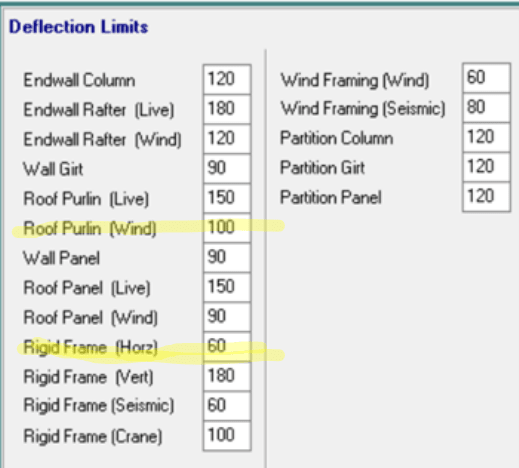thoughtofthis
Structural
In my experience, utility racks are typically designed using a deflection ratio of L/240 for beams between supports using the collateral + operating load. This can vary based on what's being conveyed in the pipes and to address specific loading conditions (e.g. - if the pipe rack is outside, you might consider snow/ice, etc). This assumes pipe racks are free standing.
However, if the racks are hung from the roof of a structure, the deflections can be additive. A PEMB rafter may deflect L/180 under a collateral + roof live/snow condition.
For example, a 8' wide rack with hangers every 25 ft @ L/240 deflects 1.25" (25'*12"/'/240, girder) + 0.4" (8'*12"/'/240, cross-beam). The rack is parallel to a rafter spanning 75' @ L/180, so the rafter deflection is 5" at mid-span (75'*12"/'/180). Assuming a hanger at mid-span of the rafter, a pipe on the center of the rack could deflect 6.65" or L/135 @ 75'. In this situation, to maintain L/240 at the rack, the deflection limits of the rack and the building would need to be increased.
This example is greatly simplified, but highlights the issue. There could be dozens of scenarios that need to be addressed in a single building. In addition, when designing the rack in a PEMB, you might not have the actual rafter stiffness or deflection until after everything is designed (at best) or never (depending on the vendor). Are there any standards, guidelines or references that cover this?
However, if the racks are hung from the roof of a structure, the deflections can be additive. A PEMB rafter may deflect L/180 under a collateral + roof live/snow condition.
For example, a 8' wide rack with hangers every 25 ft @ L/240 deflects 1.25" (25'*12"/'/240, girder) + 0.4" (8'*12"/'/240, cross-beam). The rack is parallel to a rafter spanning 75' @ L/180, so the rafter deflection is 5" at mid-span (75'*12"/'/180). Assuming a hanger at mid-span of the rafter, a pipe on the center of the rack could deflect 6.65" or L/135 @ 75'. In this situation, to maintain L/240 at the rack, the deflection limits of the rack and the building would need to be increased.
This example is greatly simplified, but highlights the issue. There could be dozens of scenarios that need to be addressed in a single building. In addition, when designing the rack in a PEMB, you might not have the actual rafter stiffness or deflection until after everything is designed (at best) or never (depending on the vendor). Are there any standards, guidelines or references that cover this?

